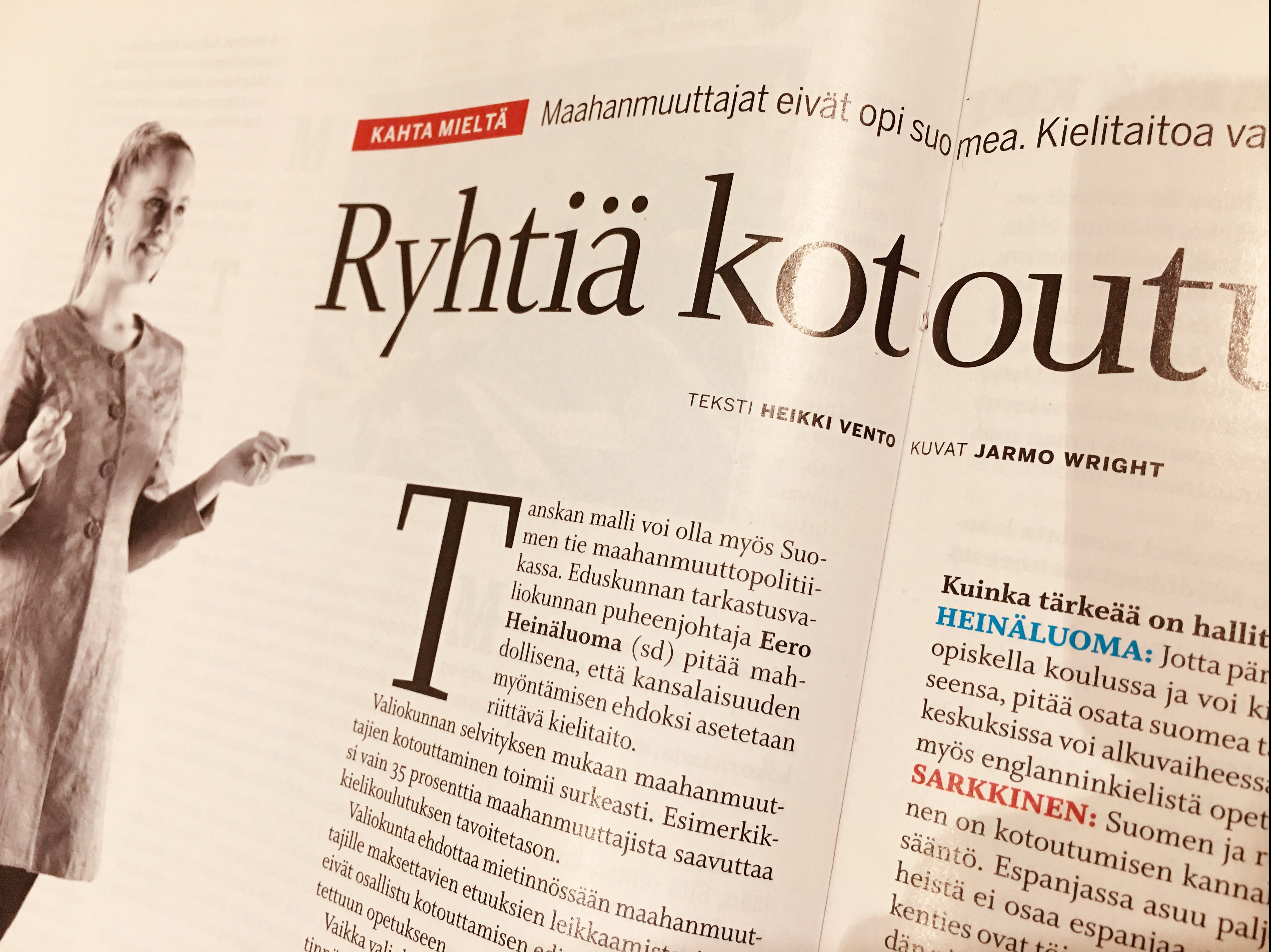Immigrants don’t learn Finnish
17.4.2020
ParagraphThis was the sensational sentence above the article’s Ryhtiä kotoutukseen headline in Suomen Kuvalehti (SK 1.2.2019, s.28-31) and it sure is true. One of the article’s references is the statement of the committee declaring that only 35% of immigrants reaches the target level of the integration courses. Target level is B1.1. according to European Framework of Languages which is equivalent of National Certificate of Language Proficiency (YKI) level 3. In YKI-exam you get four evaluations of different parts of your language skills and two of these can be under target level should the attendee wish to apply Finnish citizenship. In Suomen Kuvalehti Hanna Sarkkinen (Vas) and Eero Heinäluoma (SD) share their thoughts about what possible future acts.

Suomen Kuvalehti is asking should sufficient Finnish or Swedish skills be a condition to apply citizenship. Heinäluoma considers it to be worth of conversation where as Sarkkinen is against it. I could be cheeky about questioning the whole concept of sufficient language skills but instead I will settle for saying that this already applies. With YKI 3 you can manage everyday situations and you can, for example, express your opinion in a simple way. My oral Chinese is on that level. Could I say that I master Chinese? No way. However I manage daily situations and I can express my opinion in a simple way. It is a start. Should the language skills required for citizenship be tighter then? No. I have given besides integration courses private lessons for tens of work-based immigrants who have lived long time in Finland at the stage when they decide to learn Finnish so that they can apply the citizenship. For them YKI 3 is enough of a challenge to achieve when working full time. Also for primary or secondary illiterates can really push hard to get their reading speed into level required in the exam. Target is still not in all means impossible for anyone.
There are also different kinds of sticks flashed in the article like the language skills as a requirement of permanent residence permit or cutting the benefits if you are not attending the courses. There are no carrots though. In the worst scenario those who reach the target level can kiss good bye for integration courses, although own talents and skills would require remarkably better language skills than YKI 3. Due to this many teachers of integration courses may leave the language skills evaluation lower than it really is, to ensure customer’s possibility to continue Finnish studies. Regional change in the practices of integration courses is a cruel fact. In other areas you can only dream about attending the integration course after your 3-years integration period, other regions are able to send attendees despite the fact of living in Finland ten years or having a course or two in the past. For a course meant for unemployed also employed can join, if they only are able to ask about it or someone is able to guide them to register.
Challenges are several, on of the biggest is the calls for bids that in practice hinder the co-operation between service providers. Calls for bids raise tight conversations especially between Finnish as a second language -teachers. Service providers of integration courses are arguing with each other and good practices are left behind as a pile of papers or internet pages that no one bothers to read. Teacher criteria are risen to a level that I am not qualified anymore although I am double times Master of Art, specialized in Finnish as a second and foreign language, over ten years of teaching experience and also a specialist in competence based qualifications, not to mention separate courses and projects that I’ve attended. I can’t help thinking, is this the part that we have totally lost it? Degree doesn’t teach anyone, it requires a person. Do we have enough wisdom of the heart to teach in a manner that makes everyone learn?
I don’t find it good idea to change the governance of integration courses to municipals, nor to transfer the integration courses under the Ministry of Education and Culture. Finnish teaching should be top of the world and the lowsy results of integration courses are not due to bad host. We are dealing with adults, most often in their best working years. The clear majority of immigrants I’ve met during my career have been very motivated and active. They need to get a job and quickly, language should be learned by using and living, not by sitting in the course. You can’t put adult’s life on hold to learn a language. The target of the integration course shouldn’t be the language and according to curriculum it isn’t. Target is to be working and if that is not realistic yet, you should at least be ten steps closer to working life and independent life in Finland.

Some time ago I was talking with a Romanian guy. He had lived in Germany and lost his job. He was praising the German system. At the unemployment office they told him: You are young. We need you. Go to a course and learn German. He studied for an year and he was paid certain amount of benefits and additionally the rent. Now he is driving Uber in England. Certainly the integration can be considered to be a success as he is dreaming about returning to Germany and is very disappointed with English system. I asked how well he speaks German. He said that he manages but the course was a bit boring, too much grammar and too little of active language usage.
Now we get to a point where you have no right to advise me. If you don’t have a Masters degree in Finnish, do not tell me how I should teach. In opinion forums people tell the teaching to be too grammar based, and in between Finnish teachers we shout people to come and see, teaching is functional. Anyone can’t teach Finnish but everyone should learn it. We simply don’t have any excuses. 35% is a crappy result in a country whose teacher education is exported abroad. It is in vain to explain students are more difficult. If it is so, teachers need to be better.
In Suomen Kuvalehti Sarkkinen says it to be stigmatizing to say integration has failed. I agree, if we talk about individual integration stories, people and their paths. If we talk about numbers, integration has failed. And the numbers don’t exist in some parts as according to Heinäluoma the committee didn’t get the amounts of course attendees or the information about cutting the benefits. Stories are needed, as how otherwise I could prove an illiterate single mother of six to be closer the open job market and employment than with a story. Data and numbers are still required alongside.
Stigmatizing doesn’t help any parts of integration to go forward, least the immigrants. Every party working on integration should still be able to take a look in the mirror and to view own actions in critical mindset and to ask what I can do better. After that the most important question is what we can do together to fix it?

Follow Gimara’s YouTube-channel for the conversation about the topic. Let’s give the microphone to those who are integrating at the moment or who already went through their own integration.
Raisa Haikala
